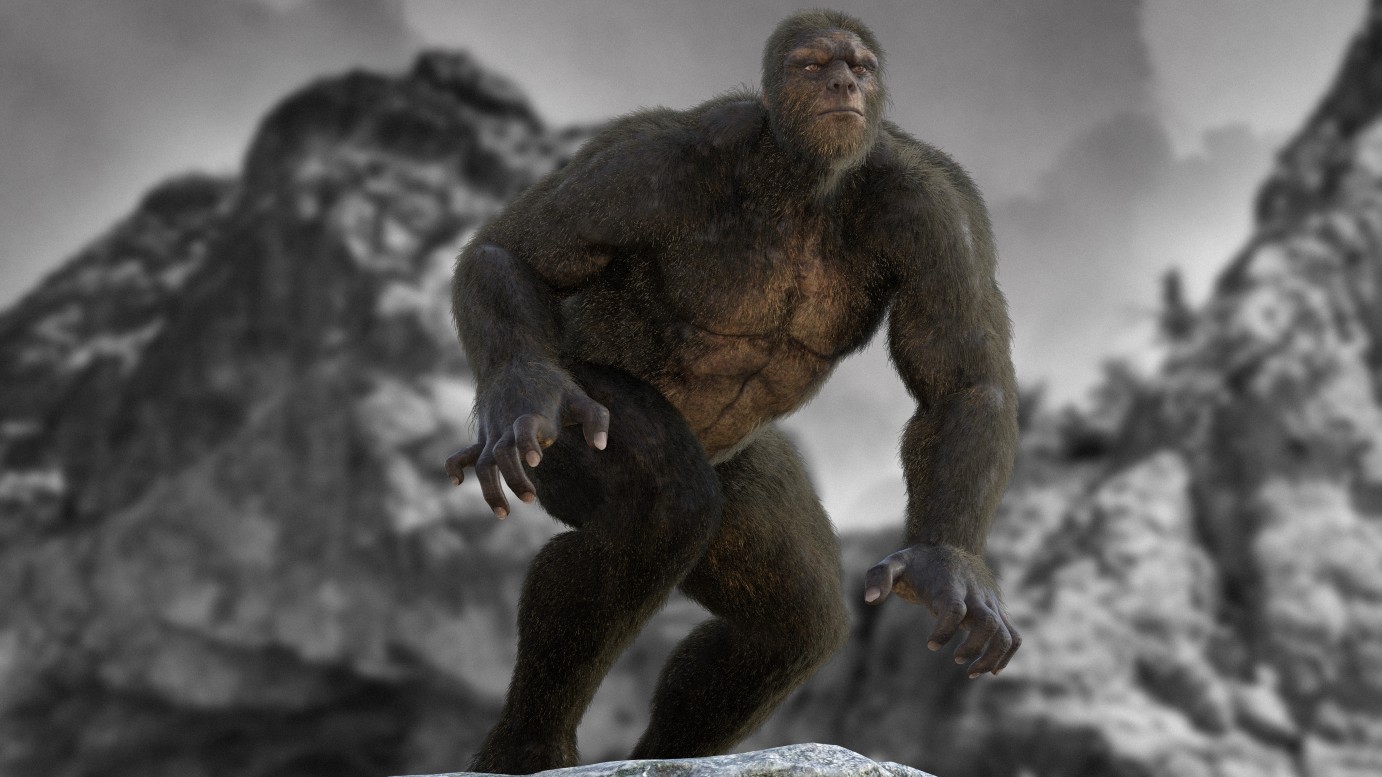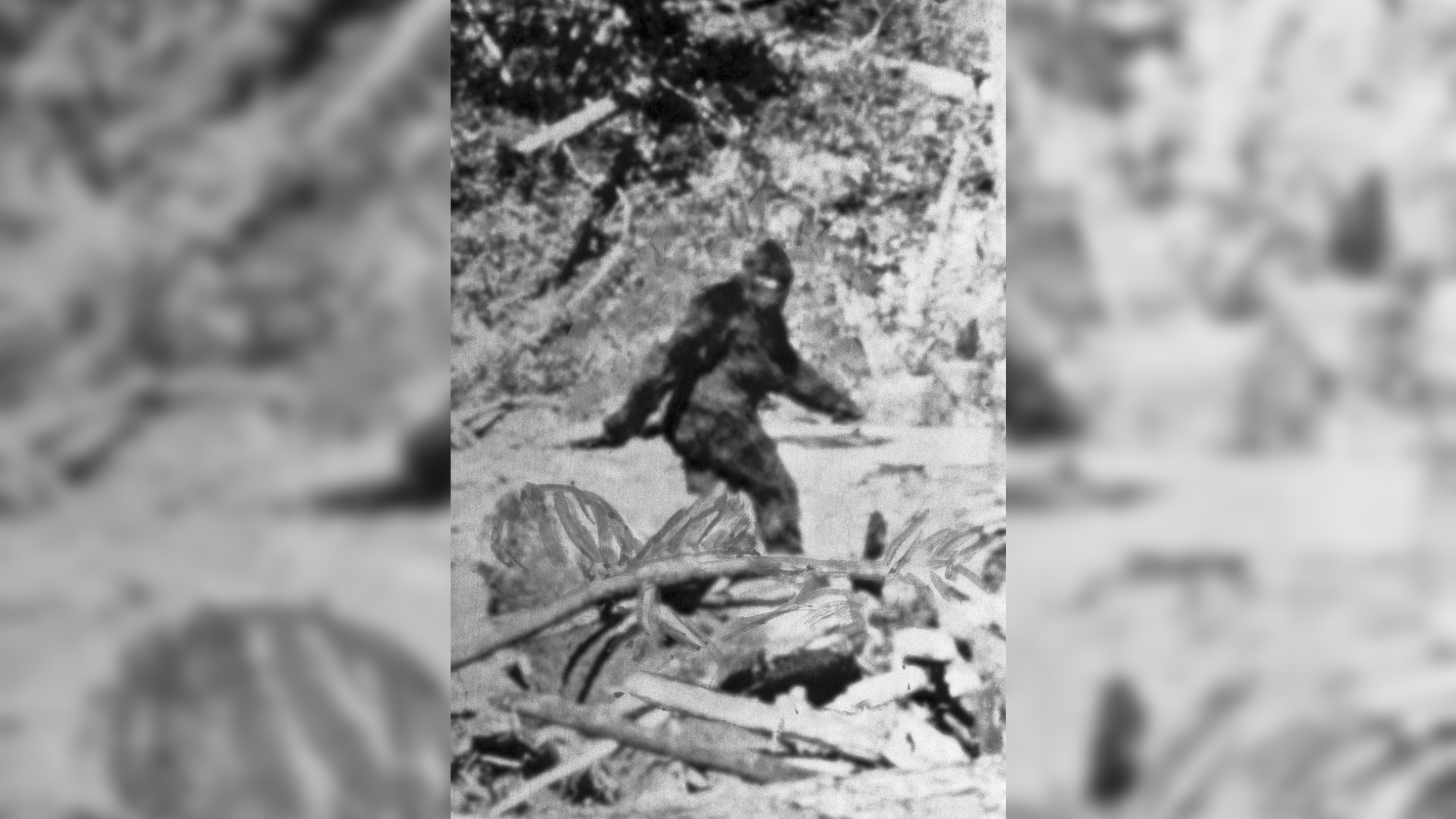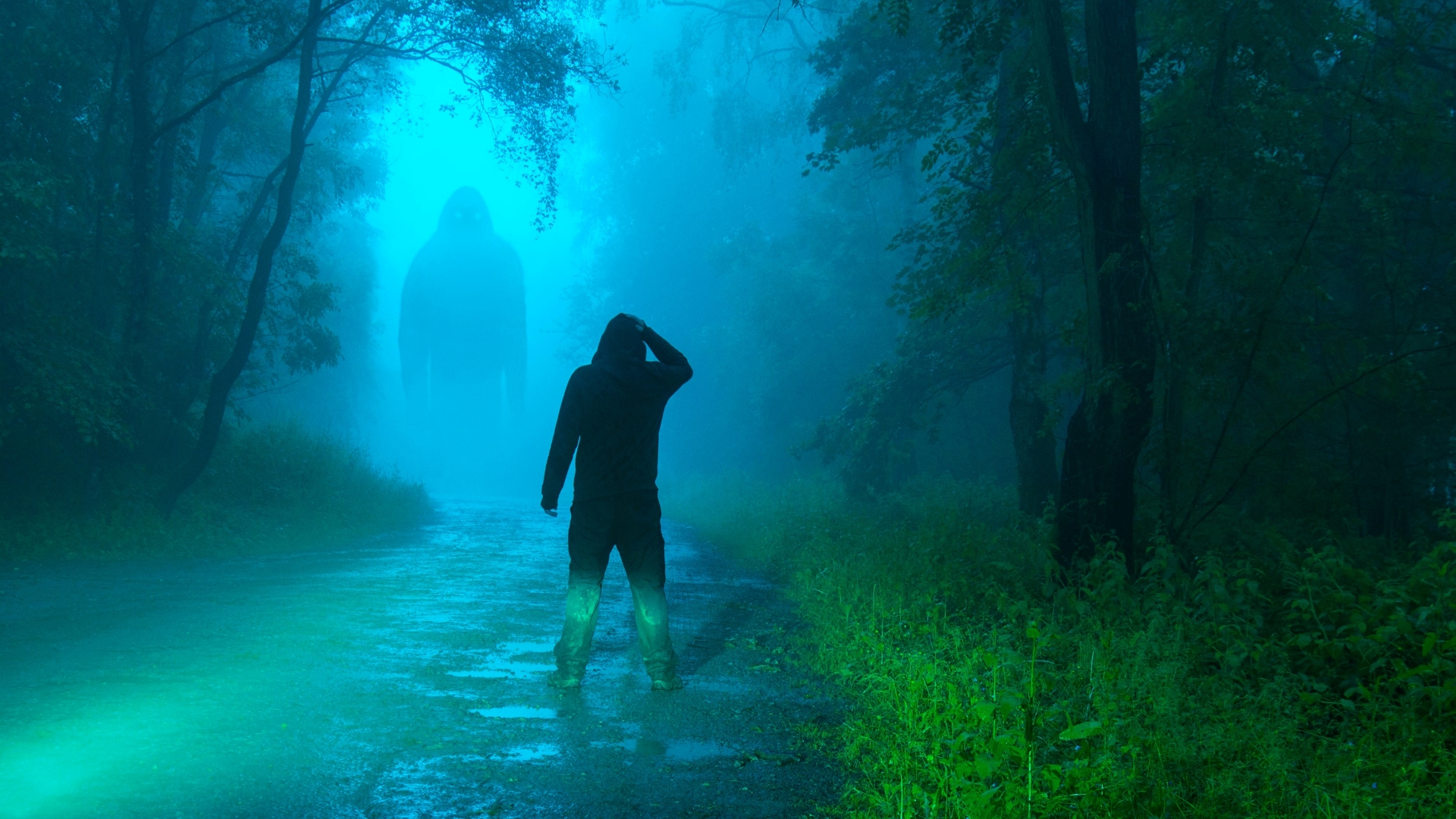The most famous Bigfoot sightings
Bigfoot, or Sasquatch, is one of North America's most enduring legends, with thousands of people claiming to have seen the giant ape-like creature. Here are the most famous Bigfoot sightings.

Bigfoot, or Sasquatch, is one of North America's most enduring legends. The scientific community largely dismisses the idea of a large, unknown ape-like creature sauntering through the forests because there's never been any hard evidence that such an animal exists.
Nonetheless, there have been thousands of reported eyewitness accounts over the last half century from people all over the U.S. and Canada. Here are some of the most famous Bigfoot sightings.
William Roe encounter: 1955
One of the most famous Bigfoot sightings allegedly occurred on Mica Mountain in British Columbia in 1955, when a man called William Roe claimed he saw a "partly human and partly animal" creature while hiking. He swore an affidavit in 1957 that the creature was about 6 feet (1.8 meters) tall and covered in brown silver-tipped hair, with thick arms reaching down to its knees, broad feet and breasts, according to the Alberta Sasquatch Organization website.
"As I watched this creature, I wondered if some movie company was making a film at this place and that what I saw was an actor, made up to look partly human and partly animal." Roe wrote in his 1957 affidavit. "But as I observed it more, I decided it would be impossible to fake such a specimen."
According to "Abominable Science! Origins of the Yeti, Nessie, and Other Famous Cryptids" (Columbia University Press, 2013), Roe's ape-like sighting marks a change from earlier Sasquatch accounts in British Columbia, which repeatedly described Sasquatch as a giant-sized Indigenous person. In other words, it was the birth of modern Bigfoot — though that name wouldn't emerge for another year. Scientists argue that eyewitness testimony isn't always reliable, so this and other sightings are not conclusive evidence.
Related: 'Expedition Bigfoot' scours Oregon woods for signs of the mythical and elusive beast
Albert Ostman abduction: 1924
Prospector Albert Ostman claimed that he spent around a week with a Bigfoot family near Toba Inlet, British Columbia in 1924. Ostman was camping alone when he says he was scooped up in his sleeping bag by a papa Bigfoot and taken to meet momma Bigfoot and two Bigfoot children. Ostman was supposedly held captive by the family, but said he eventually escaped when papa Bigfoot ate Ostman’s chewing tobacco and fell ill, according to a retelling of the story in anthropologist David Daegling's book "Bigfoot Exposed: An Anthropologist Examines America's Enduring Legend" (AltaMira Press, 2004).
Sign up for the Live Science daily newsletter now
Get the world’s most fascinating discoveries delivered straight to your inbox.
Ostman's descriptions of his captors are similar to that of Roe's 1957 account. However, Daegling points out in his book that even though Ostman said the encounter took place in 1924, he didn't write it down until 1957, after he heard Roe's tale, so he may have been inspired or influenced by Roe.
Patterson-Gimlin film: 1967

What is likely the most famous Bigfoot sighting was caught on camera in 1967. The "Patterson-Gimlin film" is a minute-long video that appears to show a female Bigfoot — later nicknamed "Patty" — walking through a clearing in Northern California. The film is still often held up by Bigfoot believers as the best piece of evidence for the creature's existence. The scientific community has overwhelmingly dismissed the film as showing a person wearing a costume.
Jeffrey Meldrum, a professor of anatomy and anthropology at Idaho State University and author of "Sasquatch: Legend Meets Science" (Forge Books, 2007), is one of the few scientists to publicly back the film and the existence of Bigfoot. Meldrum told Live Science that not only is he convinced the film is real but believes it's grown more credible over time. The creature's walk was criticized in the 1960s for being too human, but Meldrum argues that subsequent scientific discoveries, such as Lucy — an extinct, 3.2 million-year-old human ancestor (Australopithecus afarensis) — reveal our ape-like ancestors walked upright, so there's now a scientific justification for the creature’s human-like gait.
"What you see on that film is exactly how we envision something like a robust Australopithecine to look," Meldrum said. "It's almost as if now the science has finally caught up to this whole phenomenon of Bigfoot."
Meldrum noted that anatomical features visible on the film, such as the proportions of the face, match up with early humans such as Paranthropus boisei — a species that lived around 2.3 million years ago to 1.2 million years ago, according to the Smithsonian National Museum of Natural History. The size of the creature in the film is estimated to be between around 6 feet to 7 feet (1.8 to 2.1 m) tall.
Related: Closest living relative of extinct 'Bigfoot' found
However, most experts are not convinced by the footage. Darren Naish, a paleozoologist and author of "Hunting Monsters: Cryptozoology and the Reality Behind the Myths" (Sirius, 2017) summarized plenty of reasons to question the film's authenticity in a 2020 Twitter thread. Most notably, he highlights that Patterson, who shot the film, had already turned Bigfoot into a money-spinning operation before releasing it. But Naish adds that Patty's pelt appears to glisten and move like that of a real animal and her muscle movements look genuine — suggesting it's a very good hoax.
Brian Regal, an associate professor of the history of science at Kean University in New Jersey and author of "Searching for Sasquatch: Crackpots, Eggheads, and Cryptozoology" (Palgrave Macmillan, 2011), is more damning of the film and told Live Science that people project their own views onto Patty. "You look at it and you see what you want to believe," he said.
Ape Canyon: 1924
The Ape Canyon incident of 1924 wasn't so much an alleged sighting as a supposed battle. A group of gold prospectors claimed they defended their cabin against multiple "gorilla men" in a gorge — later named Ape Canyon — on the side of Mount St. Helens. One of the miners, Fred Beck, allegedly shot at a Sasquatch during the day, which prompted a gang of its hairy brethren to seek revenge come nightfall. The creatures are said to have pelted the miners' cabin with rocks and boulders, and one even reached an arm inside. The miners survived the onslaught, and as the sun rose the beasts retreated back into the woods, possibly after Beck shot one.
Beck returned to the scene with U.S. Forest Service rangers after news broke of the attack. The rangers couldn't find a Sasquatch body and apparently weren't impressed with the large stones they found next to the cabin or the supposed giant footprints nearby, the local The Oregonian newspaper reported at the time. The rangers seemed to think the miners placed the stones there themselves and that the footprints were made by a human hand.
One popular explanation for the Ape Canyon story put forward by skeptics — other than the miners simply making it up — is that the miners were actually set upon by a gang of local youths throwing rocks at the cabin for fun, according to travel website Atlas Obscura — although this doesn't account for all aspects of the story.
Related: Bigfoot's FBI file reveals strange story of a monster hunter and 15 mysterious hairs
Scott Tompkins, a data manager and founder of the Bigfoot Mapping Project — a website that hosts around 8,000 historical and modern Bigfoot sightings — told Live Science that most Bigfoot sightings he's mapped don't end in conflict.
"When people describe the behavior [of such creatures], they seem to be very curious, but non confrontational," Tompkins said.
Provo Canyon: 2012
There are many Bigfoot videos on YouTube, but few are as popular as a clip from Provo Canyon, Utah. The video appears to show a large, black animal hunched over in the trees, possibly feeding or foraging. The camera zooms in to try to get a closer look, and a few seconds later the great creature stands up on two legs as if it's bipedal. This causes the pair behind the camera to immediately turn and run away.
The video was posted on Oct. 30, 2012 and has amassed more than 7.6 million views on YouTube. According to account uploader "Beard Card," the pair were on a camping trip hoping to get a closer look at deer on a hill. "On our way up, we thought we saw a bear, until the monster stood up and looked right at us," Beard Card wrote in the video description. "We ran straight to the car after that, leaving our tent and everything behind. It's probably all still up there."
The Provo Canyon video is short and inconclusive. Eric Rickart, curator of vertebrate zoology at the Natural History Museum of Utah, told FOX 13 News Utah after a more recent alleged sighting in 2019 that the science didn't support a Bigfoot in the state.
"What’s the likelihood that there are big animals that have gone undetected by scientists and by trained observers?" Rickart said. "There are lots of things to discover, particularly in the natural world, but they don’t take the form of giant apes running around in largely settled areas of the world."
Related: Maybe Bigfoot was a dinosaur, if these fossils are any Indication
Highcliff skunk ape: 2013

Skunk apes are supposedly swamp-dwelling versions of Bigfoot that are rumored to roam the southeastern U.S. On Oct. 28, 2013, a YouTube account named "Josh Highcliff'' uploaded one of the most popular skunk ape videos. In it, the cameraman films a potential skunk ape foraging in a Mississippi swamp.
"It looks like a gorilla squatted down, big broad shoulders, little peaked head and it's pulling off chunks of wood that seems to demonstrate extreme strength. Then, all of a sudden it stands up and it's got these long legs," Meldrum said, impressed by the video but yet to examine it in detail.
The last shot of the creature in the video comes just as it stands up, similar to the 2012 Provo Canyon video. Unfortunately, people filming Bigfoot have a tendency to suddenly jerk the camera and run away just as they're about to get a good view of one — understandably fearful if the creature exists, but convenient if they're creating a hoax. This is one of many reasons why skeptics decry such videos and ask believers to produce a body.
Hoax bodies: 2008 and 2012
In 2008, two men, Rick Dyer and Matthew Whitton, claimed to possess a frozen body of a Bigfoot specimen. They said they found it while hiking in the woods in northern Georgia. Their story made headlines, but the "body" turned out to be a rubber gorilla suit, Reuters reported at the time. Dyer was in the news again in 2012 when he claimed to have shot another Bigfoot in San Antonio, Texas. He took this second "Bigfoot" on tour in 2014 and charged people to see it, before admitting it was fake, San Antonio Express-News reported at the time.
Bigfoot footprints
While not a sighting per se, Bigfoot footprints are among the most commonly reported aspects of the Bigfoot phenomenon. Even the name "Bigfoot" stems from a seemingly bogus 1958 story about giant footprints in northern California found by a man called Ray Wallace; his children later claimed that the prints were their father's prank, according to Smithsonian Magazine. Meldrum argues that hoaxers are rare and that he's got plenty of legitimate footprints that back up the masses of sightings.
"I've got over 300 footprint cast copies and original materials in my laboratory that form the basis of a remarkable body of data that attests to the fact that there is something out there leaving these footprints." Meldrum said. "And the most straightforward answer is that it's a bipedal primate species that's not recognized by science."
Skeptics, however, will wait for a body.

Patrick Pester is the trending news writer at Live Science. His work has appeared on other science websites, such as BBC Science Focus and Scientific American. Patrick retrained as a journalist after spending his early career working in zoos and wildlife conservation. He was awarded the Master's Excellence Scholarship to study at Cardiff University where he completed a master's degree in international journalism. He also has a second master's degree in biodiversity, evolution and conservation in action from Middlesex University London. When he isn't writing news, Patrick investigates the sale of human remains.









